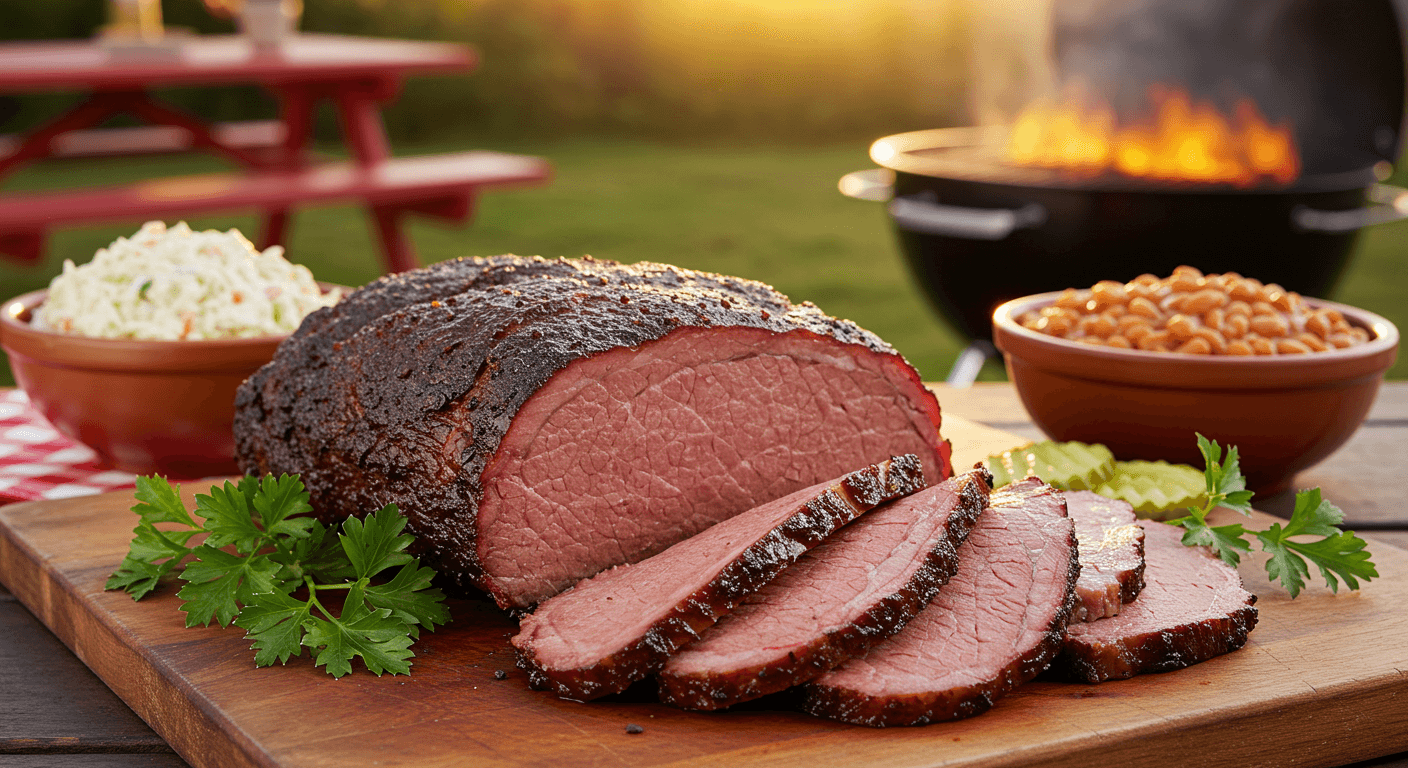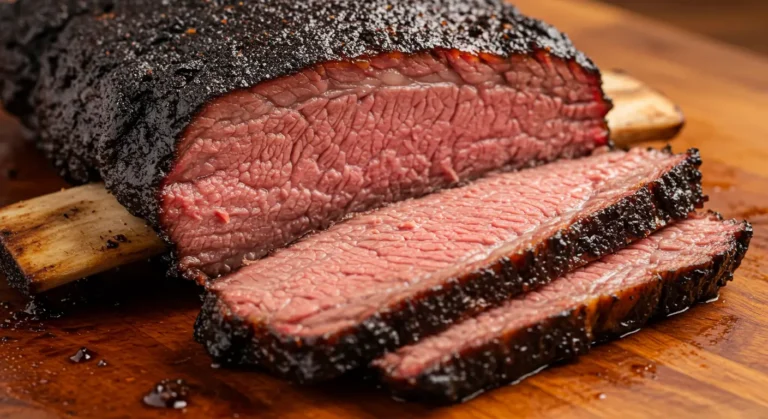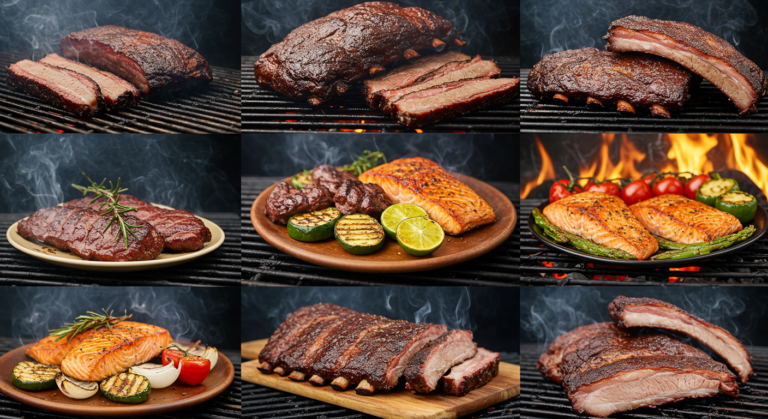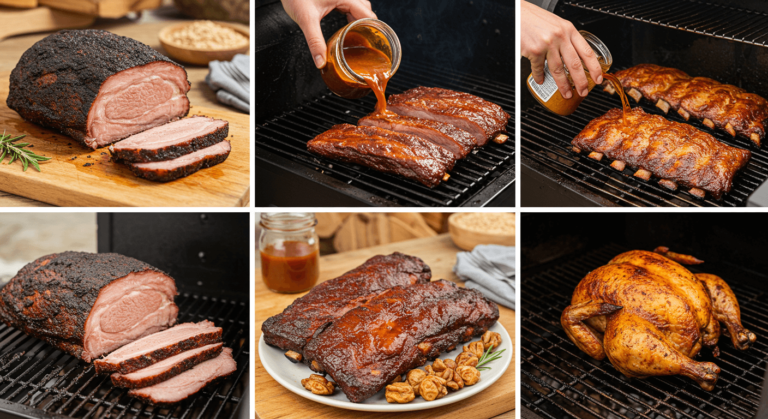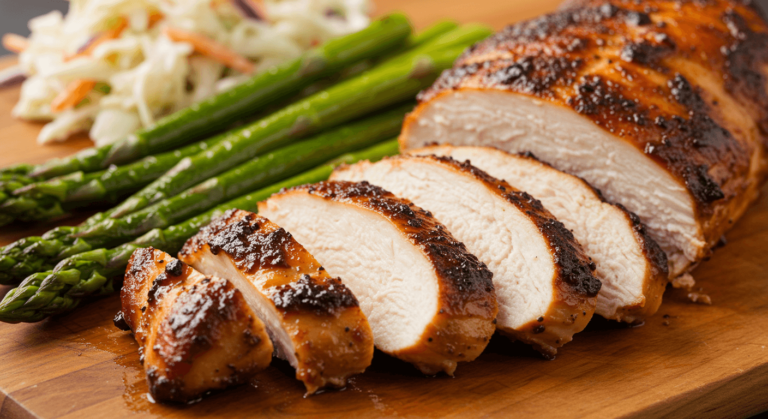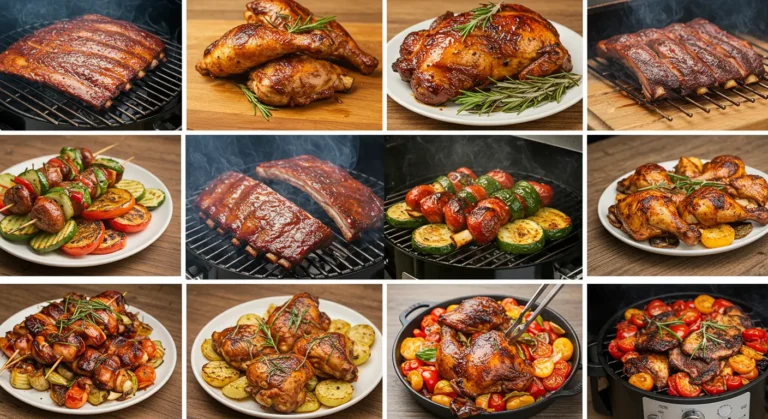How to Make the Best Smoked Chuck Roast Recipe at Home
There’s something almost magical about the moment you lift the lid on your smoker to reveal a perfectly cooked chuck roast – that beautiful bark, the intoxicating aroma of smoke and beef melding together, and the promise of tender, flavorful meat that practically melts in your mouth. If you’ve never experienced the joy of creating a smoked chuck roast recipe at home, you’re in for a real treat.
As someone who’s been smoking meats for over two decades, I can tell you that mastering a smoked chuck roast might be one of the most rewarding experiences for any home cook. It’s more affordable than brisket, more forgiving than ribs, and delivers incredible flavor that will have your family and friends convinced you’ve been hiding professional BBQ credentials.
In this comprehensive guide, we’ll walk through everything you need to know about creating the perfect smoked chuck roast – from selecting the right cut and preparing it properly, to managing your smoker for optimal results, and finally, serving up a dish that will have everyone asking for seconds. Whether you’re a smoking novice or a seasoned pitmaster looking to perfect your technique, this guide has something for you.
What Makes Chuck Roast Perfect for Smoking?
Before we dive into the how-to, let’s talk about why chuck roast deserves a prime spot in your smoking rotation.
“Chuck roast is the unsung hero of the smoker,” says championship pitmaster Aaron Franklin. “It’s got everything you want – abundant marbling, rich beef flavor, and it’s forgiving enough for beginners to have success with right away.”
Chuck roast comes from the shoulder area of the cow, which means it’s a hardworking muscle that’s full of connective tissue. This might sound like a negative, but it’s actually what makes it perfect for low and slow cooking methods like smoking. Given enough time, that connective tissue breaks down into rich, silky collagen that bathes the meat in moisture and flavor.
Additionally, chuck roast typically has excellent marbling – those little white flecks of fat that melt during cooking, keeping the meat juicy and adding tremendous flavor. And let’s not forget the price point – chuck roast is significantly more affordable than premium cuts like brisket, making it perfect for weekends when you want to practice your technique without breaking the bank.
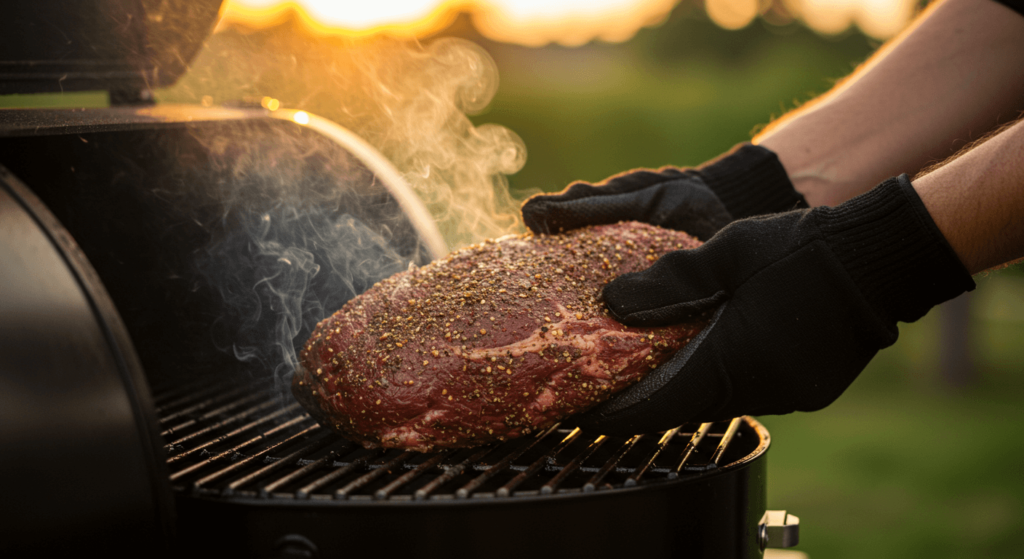
What Equipment Do You Need for Smoking Chuck Roast?
While I’ll cover smoker types in more detail shortly, here’s what you’ll need to get started:
- A smoker (any variety will work for chuck roast)
- Smoking wood (chunks, chips, or pellets depending on your smoker)
- Meat thermometer (preferably an instant-read and a leave-in probe)
- Aluminum foil or butcher paper
- Cutting board and sharp knife
- Drip pan
- Spray bottle for spritzing
- Good quality BBQ rub
How to Select the Perfect Chuck Roast for Smoking
Not all chuck roasts are created equal. When you’re at the meat counter, here’s what to look for:
- Size matters: Look for roasts between 3-5 pounds. This size range provides the perfect balance of surface area for bark formation and thickness to maintain moisture.
- Marbling is your friend: Select a roast with good fat distribution throughout. This intramuscular fat is what makes the difference between a good roast and a great one.
- Uniform thickness: Try to find a roast that has relatively even thickness throughout, which helps ensure even cooking.
- Fresh is best: Look for bright red meat with white (not yellow) fat.

What’s the Best Wood for Smoking Chuck Roast?
Wood selection can dramatically impact the flavor profile of your finished chuck roast. Here are some excellent options:
- Oak: Provides a medium-strong smoke flavor that pairs wonderfully with beef without overpowering it. This is my go-to for chuck roast.
- Hickory: Offers a stronger, bacon-like smoke profile that many BBQ enthusiasts love for beef.
- Mesquite: Delivers the strongest smoke flavor – use sparingly or mix with milder woods.
- Cherry or Apple: For a milder, slightly sweet smoke flavor that works well when mixed with stronger woods like oak or hickory.
Pro tip: For your first few smoked chuck roasts, consider using oak or a blend of oak and cherry. This provides a classic smoke flavor that complements beef without overwhelming it.
How Do You Prepare Chuck Roast for the Smoker?
Trimming the Chuck Roast
Unlike brisket, chuck roast typically doesn’t require extensive trimming. However, you’ll want to:
- Remove any hard pieces of fat that won’t render during cooking
- Trim down any unusually thick fat caps to about 1/4 inch
- Remove any silverskin (that shiny connective tissue) that’s easily accessible
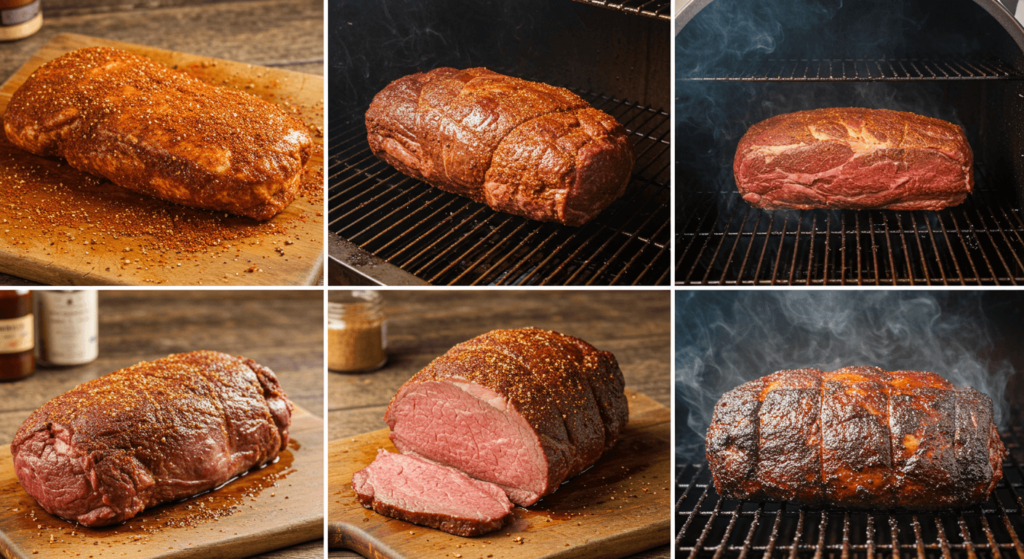
The Perfect Rub for Smoked Chuck Roast recipe
While there are countless commercial rubs available, nothing beats a homemade version tailored to your taste preferences. Here’s my tried-and-true chuck roast rub:
- 2 tablespoons coarse kosher salt
- 2 tablespoons coarse black pepper
- 1 tablespoon garlic powder
- 1 tablespoon onion powder
- 2 teaspoons paprika
- 1 teaspoon mustard powder
- 1/2 teaspoon cayenne pepper (adjust to your heat preference)
Mix all ingredients thoroughly and store any unused portion in an airtight container.
For application:
- Pat the chuck roast dry with paper towels
- Apply a thin layer of olive oil or mustard as a binder
- Apply the rub generously on all sides, pressing it into the meat
- Let the seasoned roast sit at room temperature for 30-45 minutes before smoking
What’s the Best Way to Smoke a Chuck Roast?
Temperature Settings
For chuck roast, the sweet spot is smoking at 225-250°F. This temperature range allows the connective tissue to break down properly without drying out the meat. smoker chuck roast recipe
The Smoking Process Step-by-Step
- Preheat your smoker to 225°F, ensuring clean smoke before adding the meat
- Place the chuck roast on the smoker with a water pan nearby to maintain humidity
- Insert a probe thermometer if you have one, positioning it in the center of the roast
- Maintain steady temperature throughout the cook, adjusting vents as needed
- Spritz occasionally (every 45-60 minutes) with apple juice, beef broth, or water to keep the surface moist
- Monitor internal temperature rather than relying solely on time
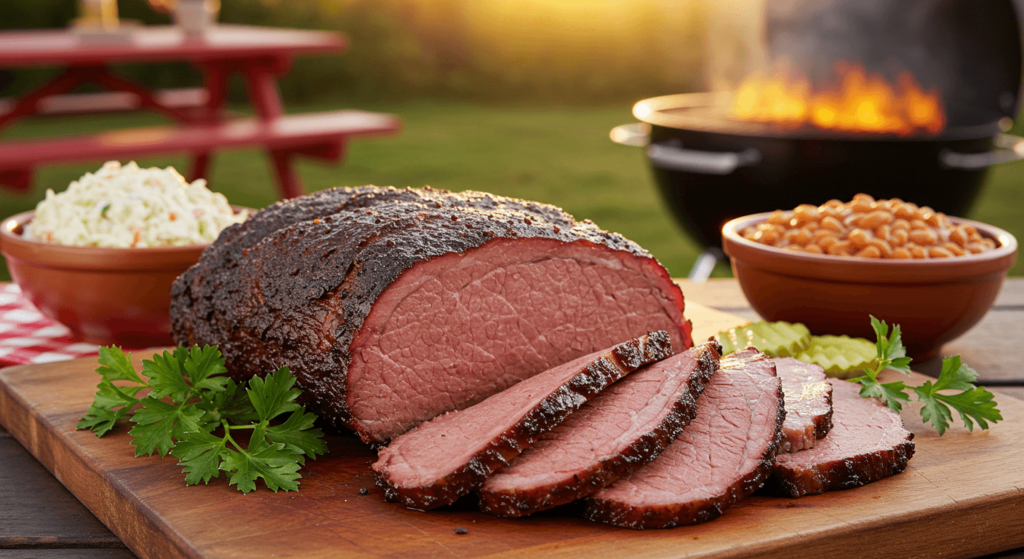
How Long Does It Take to Smoke a Chuck Roast?
The honest answer is: it takes as long as it takes. However, for planning purposes:
- Plan for approximately 1.5 hours per pound of meat
- A 4-pound chuck roast will typically take 6-7 hours total cooking time
- Always cook to temperature, not time
Understanding and Managing the Stall
If you’ve smoked brisket before, you’re familiar with “the stall” – that frustrating period when the internal temperature seems to stop rising. Chuck roast experiences a similar phenomenon, typically around 150-160°F.
This happens because the meat is releasing moisture at the same rate it’s absorbing heat, creating a cooling effect. There are two approaches to handling the stall:
- Push through it: Simply wait it out. This method preserves the best bark formation but extends cooking time.
- The Texas Crutch: Once you hit the stall, wrap the roast tightly in butcher paper or foil, then return it to the smoker. This speeds up cooking but sacrifices some bark quality.
For beginners, I recommend the Texas Crutch method until you gain more experience with temperature management.smoke chuck roast recipe
When Is Smoked Chuck Roast Done?
Unlike steaks, chuck roast isn’t about reaching a certain doneness level – it’s about breaking down those tough muscle fibers into tender goodness.
The magic number for perfectly smoked chuck roast is 200-205°F internal temperature. At this point, the collagen has properly rendered, creating that melt-in-your-mouth texture we’re after.
However, temperature isn’t the only indicator. A properly done chuck roast should:
- Pass the “probe test” – your thermometer should slide in with almost no resistance, like pushing through warm butter
- Have a slight jiggle when you gently shake the meat
- Show visible pulling back of the meat from the edges
Resting Your Smoked Chuck Roast
This step is non-negotiable! After removing your roast from the smoker:
- Wrap it tightly in butcher paper or foil if not already wrapped
- Place it in a cooler or insulated container (without ice)
- Let it rest for at least 30 minutes, though 1 hour is better
- This allows juices to redistribute throughout the meat
Skipping the rest will result in dry meat and all those precious juices ending up on your cutting board instead of in your mouth.smoked beef chuck roast recipes
How Do You Slice Smoked Chuck Roast?
Chuck roast has varying grain directions throughout the cut, which makes proper slicing a bit tricky. Here’s how to handle it:
- Place the rested roast on a cutting board
- Identify the direction of the meat fibers in each section
- Slice perpendicular to the grain in each section
- Aim for pencil-thickness slices (about 1/4 inch)
- If the meat starts to fall apart, you’ve achieved proper tenderness and can simply pull it instead of slicing
What Are the Best Ways to Serve Smoked Chuck Roast?
The versatility of smoked chuck roast is one of its greatest attributes. Here are some serving suggestions:
- Traditional platter: Sliced with sides like coleslaw, baked beans, and cornbread
- Sandwiches: Either sliced or pulled on a toasted bun with BBQ sauce
- Tacos: Shredded with fresh toppings and a squeeze of lime
- Hash: Chopped and crisped up with potatoes and onions, topped with a fried egg
- Chili: Cubed and added to your favorite chili recipe for amazing depth of flavor
How Do You Troubleshoot Common Chuck Roast Smoking Problems?
Dry Meat
If your chuck roast turns out dry, consider these potential causes:
- Smoking temperature too high
- Final internal temperature too high
- Insufficient marbling in the original cut
- Inadequate spritzing during the cook
- Not resting the meat properly
Tough Meat
If your roast is tough, it’s almost always because:
- You didn’t cook it long enough (internal temperature too low)
- You sliced with the grain instead of against it
Bark Issues
If your bark isn’t developing properly:
- Ensure you’re not spritzing too frequently
- Check that your rub has enough salt and sugar for proper bark formation
- Consider smoking without wrapping for longer
Advanced Tips for Smoked Chuck Roast Masters
Once you’ve mastered the basics, try these advanced techniques:
- Injection: Create a simple injection with beef broth, Worcestershire sauce, and melted butter for extra juiciness
- Compound butter: Place pats of herb-infused butter on top of the roast during the final hour of cooking
- Double smoke: Smoke your roast, refrigerate overnight, then smoke again at a higher temperature to reheat and add more smoke flavor
- Coffee rub: Add 1 tablespoon of finely ground coffee to your rub for amazing color and depth of flavor
Frequently Asked Questions About Smoking Chuck Roast
Conclusion: The Joy of Mastering Smoked Chuck Roast
There’s something deeply satisfying about transforming a humble cut of meat into something extraordinary through patience, fire, and smoke. As you practice your chuck roast smoking technique, you’ll develop an intuitive sense for when to spritz, when to wrap, and exactly how the meat should feel when it’s done to perfection.
Remember that every smoker is different, and environmental factors like humidity and outdoor temperature can affect your cook times. Keep a smoking journal to track your results and make notes for future cooks.
Most importantly, enjoy the process. Smoking meat isn’t just about the destination – it’s about the journey. The hours spent tending your fire, adjusting vents, and occasionally peeking at your beautiful beef creation are part of what makes BBQ culture so special.
So fire up that smoker, grab a cold beverage, and settle in for one of the most rewarding culinary adventures you can have in your own backyard. Your perfectly smoked chuck roast awaits!
Texas-Style Smoked Chuck Roast
Have You Tried This Recipes!
I’ve been smoking meats for years but never gave chuck roast the attention it deserved until I found this recipe.
WOW! The detailed temperature guidance and that coffee rub suggestion changed everything for me. I followed the instructions exactly, including the 1-hour rest in a cooler, and the result was incredible – tender enough to pull apart with a fork but still sliceable. My family demolished it in one sitting! The tip about watching for the probe to slide in like butter instead of just relying on temperature readings was spot-on. This has officially replaced brisket as our weekend smoking project because it’s more affordable and honestly just as delicious. Already planning to make it again this weekend!

